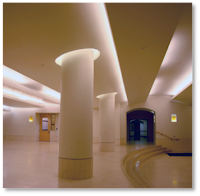This week’s discussion
of technology and art opened my mind to the concept that art is a significant contributor
to technology used in medicine. I was intrigued
to learn how x-rays began. Concerning
tools, Professor Vesna explained that at one time if a Doctor used tools or
technology, they were not considered a Doctor.
That was very odd. Wilhelm
Rontgen who was a physicist discovered X-rays.
The name x-rays employs the mathematical designation “x” – the symbol for
an unknown.
 | |
| Wilhelm's wife's hand under x-ray technology |
|
While researching
art and x-rays, I came across an article, which discusses the use of x-ray
technology to study artwork. Types of
materials used in paintings can be discerned when x-ray technology is applied. We can also discover where and when a
painting was created through x-ray technology because of the kinds of minerals found
in the materials, the canvass and the paints.
An example is Vermeer’s “The Girl with a Pearl Earing”. An x-ray of that painting revealed that lead
was used in the piece, which was a primary component in white paint. The discovery gives us clues, based on the
details of the lead used in the painting, where and when the piece was created.
 |
| Girl With a Pearl Earing http://www.artexpertswebsite.com/scientific-tests/x-ray-examination.php |
 |
| Girl With a Pearl Earing under x-ray technology http://www.artexpertswebsite.com/scientific-tests/x-ray-examination.php |
Artist Hugh Turvey
creates artwork-employing x-rays of different objects. One of his pieces is of his wife’s foot in a
stiletto developed with x-ray technology.
He notes, “We all understand that your foot is
going through quite a lot when it is in a stiletto, but to actually physically
see it and to see the angle of the bones…” (Gambino). Turvey has coined a term for his work: “xogram”. It describes his work as a mash-up of an
x-ray and a photogram. He creates them by
placing an object directly on light sensitive paper and exposing it to x-rays.
 |
| Hugh Turvey's wives foot in a stiletto
http://www.smithsonianmag.com/arts-culture/x-rayart-deeper-look-everyday-objects-180949540/?no-ist
|
 |
| Hugh Turvey's "xogram" artwork
http://www.smithsonianmag.com/arts-culture/x-ray- art-deeper-look-everyday-objects-180949540/?no-ist
|
Sources:
Art Experts. “X-ray
Examination.” 24 April 2016. Web. http://www.artexpertswebsite.com/scientific-tests/x-ray-examination.php
Gambino, Megan.
“X-Ray Art: A Deeper Look at Everyday Objects.” 3 February 2014. 24 April 2016. Web. http://www.smithsonianmag.com/arts-culture/x-ray- art-deeper-look-everyday-objects-180949540/?no-ist
Bakalar, Nicholas.
“X-Rays, 1986.” 15 June 2009. 24 April 2016. Web.
Vesna, Victoria.
“Http://www.youtube.com/v/FIX-9mXd3Y4.” Lecture. Medicine pt3. Youtube, 22 Apr. 2012. Web. 24 April
2016. http://www.youtube.com/watch?v=FIX-9mXd3Y4
Vesna, Victoria.
“Http://www.youtube.com/v/psjnQarHOqQ.” Lecture. Medicine pt2 .Youtube, 21 Apr. 2012. Web. 24
April 2016.










